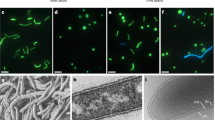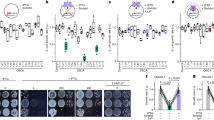Abstract
PREVIOUS investigations of the relationship in Chlorella between rate of photosynthesis at high light intensities and concentration of carbon dioxide have been made using cells suspended in alkaline solutions1. In such solutions cells grown in 4 per cent carbon dioxide show an unusually long induction phase (t½, 40–50 min.) at low concentrations of carbon dioxide; but when allowance is made for this and the rate of photosynthesis in the steady state alone considered, half the maximum rate is attained with a concentration of carbon dioxide2 of 0.9 × 10−6 M at 25° C. The possibility has been suggested that in alkaline solution the relatively high concentration of bicarbonate ion affects the rate of photosynthesis3.
This is a preview of subscription content, access via your institution
Access options
Subscribe to this journal
Receive 51 print issues and online access
$199.00 per year
only $3.90 per issue
Buy this article
- Purchase on Springer Link
- Instant access to full article PDF
Prices may be subject to local taxes which are calculated during checkout
Similar content being viewed by others
References
Whittingham, C. P., Ph.D. thesis, Cambridge (1949).
Briggs, G. E., and Whittingham, C. P., New Phytol., 51, 236 (1952).
Steemann Nielsen, E., Physiol. Plantarum, 5, 145 (1952).
Egle, K., and Schenk, W., Beiträge z. Biol. der Pflanzen, 29, 75 (1951).
Author information
Authors and Affiliations
Rights and permissions
About this article
Cite this article
WHITTINGHAM, C. Rate of Photosynthesis and Concentration of Carbon Dioxide in Chlorella. Nature 170, 1017–1018 (1952). https://doi.org/10.1038/1701017b0
Issue Date:
DOI: https://doi.org/10.1038/1701017b0
This article is cited by
Comments
By submitting a comment you agree to abide by our Terms and Community Guidelines. If you find something abusive or that does not comply with our terms or guidelines please flag it as inappropriate.



